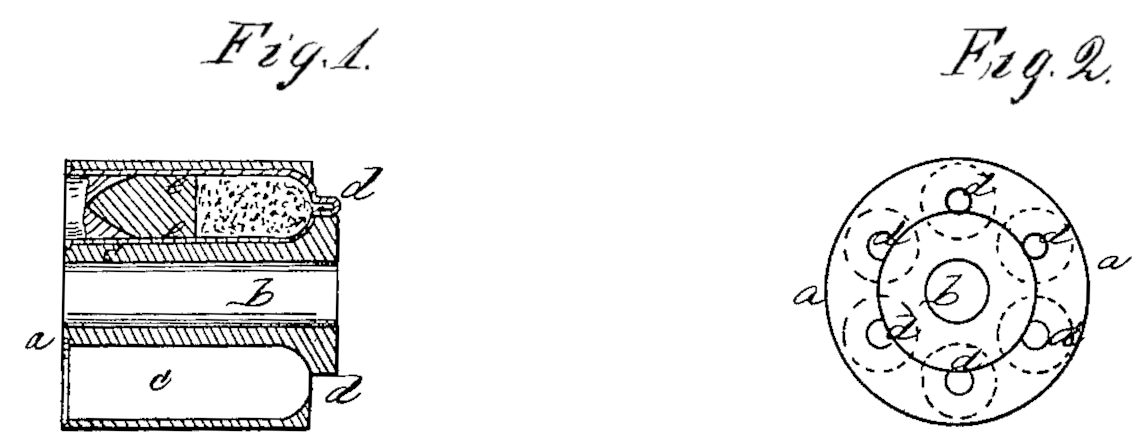US 41184
UNITED STATES PATENT OFFICE.
DAVID WILLIAMSON, OF BROOKLYN, NEW YORK, ASSIGNOR TO THE · MOORE’S PATENT FIRE-ARMS COMPANY, OF SAME PIACE.
IMPROVEMENT IN REVOLVING FIRE-ARMS.
Specification forming part of Letters Patent No. 41,184, dated January 5, 1864.
To all whom it may concern:
Be it known that I, David Williamson, of Brooklyn, in the county of Kings and State of New York, have invented, made, and applied to use a certain new and useful Improvement in Revolving Fire-Arms; and I do hereby declare the following to be a full, clear, and exact description of the same, reference being had to the annexed drawings, making part of this specification, wherein—
Figure 1 is a section of my improved cylinder for a revolving fire-arm, and Fig. 2 is a rear elevation of the same.
Similar marks of reference denote the same parts.
Several different kinds of metallic cartridges have been made for the cylinders of revolving fire-arms to be entered into the chambers from the front end, and cylinders of various constructions have been made for such cartridges. I have therefore only represented in the drawings the cylinder itself, containing a metallic cartridge, as the handle or stock, hammer, and barrel are well known and form mo part of this present invention. Radial chambers have also been formed with a tapering powder-space, and a nipple has been formed on a metallic cartridge-case projecting from the rear end of the cylinder, as in the patent of D. Moore, dated April 28, 1863. In such cases the cylinder has been increased in length to contain the necessary charge of powder, or else a portion of the rear of the cartridge has been exposed. I have discovered that the necessary strength for an abutment in the cylinder itself, at the rear end of each chamber, is obtained when the chamber is formed with a taper or hemispherical end commencing at the rear end of the cylinder. Thereby the necessary powder-space can be obtained without increasing the length of the cylinder, and hence my invention relates to a cylinder of parallel chambers formed in this manner.
In the drawings, a is the cylinder, to be mounted on am axis through the hole b.
c c are the chambers to receive the metallic cartridges, and the cylinder is to be rotated by the well-known means to bring the chambers successively into line with the barrel. The rear.or inner ends of the chambers are hemispherical, as shown, so as to terminate at the rear openings, d d; or the said rear ends of the chambers might be conical or tapering from the openings d d to the parallel portions of the chambers. By this construction the metallic cartridge-case is sustained at the rear end, and provision made for exploding such cartridge by striking the same at the opening d by any ordinary hammer.
I have represented a metallic cartridge-case at e with a nipple projecting. through the opening d, which nipple contains the fulminating material; and the shape of this nipple or other device for holding the fulminating or detonating material may be varied as desired, so long as the same is at the opening d to be struck by the hammer.
What I claim, and desire to secure by Letters Patent, is—
A series of parallel chambers in the cylinder of a revolving fire-arm, in which the inner or rear ends of the chambers are contracted ima hemispherical or tapering form from the ordinary caliber of the chamber to the rear end of the cylinder, so that am abutment is obtained in the cylinder itself at the rear of each chamber without requiring an increase in the length of such cylinder, as specified.
In witness whereof I have hereunto set my signature this 1st day of December, 1863.
D, WILLIAMSON,
Witnesses:
A. J. Bergen,
H, N, Brush.

